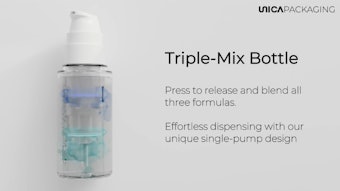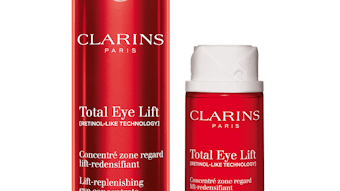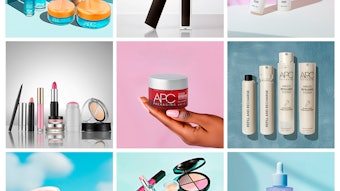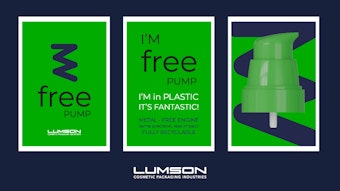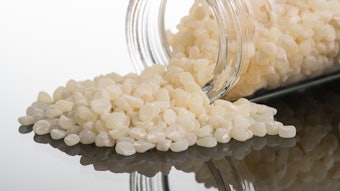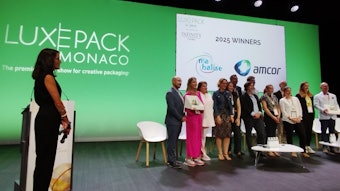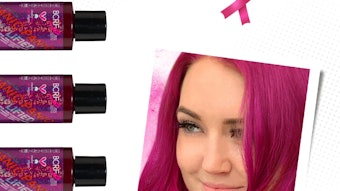New ideas for beauty packaging can come from almost anywhere—the produce section at the grocery store, the interior of a car, the playground at a park… the list goes on and on. And packaging itself is important. As Eric Desmaris, business development director for Mega Airless, says, “[Brands] know that packaging delivers tremendous return-on-investment. It represents a critical brand touch point. Every year, in markets both developed and emerging, consumers get more sophisticated. The bar is continually raised in terms of how the package looks, feels, operates. No wonder the premium-type packaging once only found in the prestige brands is now regularly found throughout the personal care product spectrum.”
Here, we check in on new innovations from beauty industry packaging suppliers, as well as learn about how they are coming up with their new ideas.
Skin, Body and Hair
In packaging development across the beauty industry, and particularly in skin care, environmentally friendly options hold a growing sway. CCL Tube recently developed a hybrid tube that combines post-consumer recycled (PCR) resin and a sugar cane ethanol-based resin in a proprietary process that ensures the PCR material does not come into direct contact with the product. It also provides an increased capacity for decoration by extruding a sleeve with PCR sandwiched between two layers of virgin resin. And by replacing the virgin resin with bio-resin, a brand could greatly reduce the environmental impact of its product packaging.
In another eco-friendly approach, Moto Okawa, marketing manager for wipes company Diamond Wipes International, says, “Beginning this year, we had made a strategic shift to replace all our compostable 100% rayon wipe substrate materials with FSC- (Forest Stewardship Council) and Rainforest Alliance-certified papers.”
He describes that the drive for such decisions come from collaborative efforts between supplier and clients. “Oftentimes, the new innovative ideas are developed during discussions with our contract packaging customers, who are brand owners or brand marketers,” Okawa acknowledges. “In retail store brand and private label areas, our customers are becoming increasingly more demanding of suppliers to take on the role of an idea and thought leader. We also have an interdepartmental collective [form an] innovation task force responsible for researching, understanding and analyzing the current trends and project what is expected in the future and how the innovation can be packaged in a wipe form.”
Des McEttrick, market development director for beauty with Aptar, says of her company’s development strategy, “Our process usually starts with researching and predicting trends. Creative ideation sessions are born from that, and those ideas help us develop product concepts to address trends and unmet needs. Consumer testing follows to gather insights, which help us further develop concepts with meaningful value and also to tweak functionality and design. Once we’ve identified concepts that really offer a better consumer experience, then we begin working on launching.”
One of the new packaging products Aptar has developed through this process is the Serumony pack. “Serumony delivers precision and simplicity in an airless package,” describes McEttrick. “The minimalistic design offers an innovative way to dispense and apply delicate beauty serums, one-touch. With light pressure on actuation, Serumony provides the right dose of formula while reinforcing its hygienic properties. A drop of serum is dispensed directly onto the skin without ever touching the tip of the applicator.”
The “no-waste” attribute for beauty, and particularly skin care, packaging is a growing trend as well, setting up for more airless options. Mike Warford, director of sales for ABA Packaging Corp., which is the exclusive distributor of Promens personal care packaging in North America, notes, “Promens has expanded its AirFree product offerings to now include a unique, innovative airless jar package. Manufactured at Promens’ Barcelona facility, the Slidissime airless jar package combines the airless pouch technology with a flexible touch and slide pump.”
Desmaris also shares some of Mega Airless’s packaging developments, noting, “The differentiation in our all-airless solution portfolio can take the form of functional and aesthetic appeal. In the case of our swirl filling capabilities, it covers both. In addition, our hot stamping capability represents a fusion of the most desirable packaging characteristics for products with advanced formulations: the protection only the true airless pack can provide with the brand building decoration that differentiates and attracts consumers at the point of sale. And the Mega Airless + Gaplast’s Bag-in-Bottle solutions offer several compelling advantages. A defined fixing of the inner bag at the bottle’s bottom and neck results in less residue as the bag collapses. Further, the system provides efficient evacuation, reliability and production efficiency, thanks to fewer parts.”
Another packaging trend is premiumization, alluded to by Mega Airless’ Desmaris. In a similar vein, Damien Dossin, president of HCP Packaging USA, shares details about HCP’s Azure Jar, saying, “It is a thick-walled outer jar in glass-like PMMA, which offers no risk of glass breakage and an improvement in decoration capability with a top plate feature that can be embellished to carry a logo or be molded in transparent PMMA with a decoration underneath.”
Regarding body care products, Philip Brand, global marketing director of Lindal Group explains of a recent innovation from his company, “Our twist-lock actuator, Sunny, is quite exciting. It is an appealing new alternative for makers of deodorants and antiperspirants, sun protection and self-tanning products, among others. The Sunny has an attractive, ergonomic design, developed for easy actuation and high top-load resistance.”
And Carole Grassi, marketing director for dispensers for Albéa, shares, “Of course, advanced formulations require new levels of protection. Therefore, we continue to work on designs that protect against oxidation and drying. In addition, we are excited about our next-generation EZ foamer, the EZ’R, one of the first squeeze foamers on the market. This is a new [format] that consumers are taking to in a big way. Plus, it’s easy to customize, opens new design possibilities with its flip-top cap, and delivers new levels of differentiation. This is our squeeze foamer platform, perfect for facial care, sun care, body care and hair care products thanks to ‘EZ’ one-hand operation.”
Trends like eco-friendliness, no-waste and premiumization show up throughout beauty packaging, and not just in skin and hair care product packs. So, while knowing that particular trends may be more plentiful or seem to apply better in certain categories, it is always good to look across your product portfolio to see where trends can be cross applied—a true mark of innovation.
Color Cosmetics
Packaging for color cosmetics often sees a lot of unique innovation, as it is very different from the bottles, tubes and jars often used for skin, body and hair care.
For example, Sandra Hutson, sales and marketing director with Topline Products, explains, “Two packaging innovations by Topline immediately come to mind: L’Oréal’s EM Life Palette and Maybelline’s Color Elixir lip balm. The EM Life Palette reflects the lifestyle of today’s high-tech, demanding makeup consumer. The packaging is super practical but stylish, with a shape and size inspired by tablet computers. The package is also exciting for its technical achievements. The compact comes with magnetic closures coated in white to match the package’s white base platform. The closures are so precisely fixed into the compact that there are no visible adhesive marks on the clear, transparent surfaces. Moreover, Topline perfectly executed the precision placement of the compact’s lid graphics. The label edges are completely invisible, with absolutely no surface imperfections. The whole effect is that the finished palette feels, and looks like a piece of luxury craftsmanship.”
For the Maybelline Color Elixir lip product, Hutson notes, “Topline produced an elegant but colorful package, mixing transparency, color, shine and quality to make the product stand out from the competition and encourage point-of-purchase buying. With its thick-walled base and anodized, shiny silver metal cap, the Maybelline package has the look of a chic lipstick, but it’s the package’s see-through color that really captures the consumer’s attention. The transparent packaging is part of a modern, fun, exciting design that gives an eye-catching splash of color to store shelves with its striking array of 20 lip shades.”
In color cosmetics, allowing consumers to see the actual product is a big trend, helping them better identify colors they like and want to purchase instead of solely relying on labels. Warford, who notes that ABA Packaging Corp. is also the exclusive North American distributor for OekaBeauty packaging solutions, shares, “OekaBeauty has developed a two-component, blow-molded lip gloss vial in conjunction with its manufacturing partner Inotech. Known as the 2-C program, the patented molding process enables them to produce high-end, injection blow-molded lip gloss vials with a molded-in see-through window design. The consumer can now see the color of the gloss through the ‘lips’ window, while the opacity of the rest of the vial protects the formula from unwanted light infiltration. And OekaBeauty and Inotech hope to take on custom projects to provide other clear window images.”
Bringing this type of innovation out to other color cosmetic products, Jessica Cahalen, director of marketing for Fusion Packaging, says, “We launched our patent-pending Scene bottle this year, which features a shatterproof, clear and glass-like shade base that is ideal for foundations, primers, tinted moisturizers, alphabet creams and formulas with unique coloring. Brands are showing interest in the bottle because it disguises formula separation, has a large area for branding, and the base shows the shade while on display.”
Fusion Packaging’s creative director Alexander Kwapis expounds further on the development of the Scene package, saying, “The design for the Scene bottle stemmed from our goal of solving a problem with current foundation packaging on the market. We wanted to create a package that hid formula separation common with these types of color products while still allowing consumers to preview the shades while on display or at point of sale. We visited retailers and looked at current packaging for lip gloss that featured shade buttons, and we really liked that design.”
Kwapis goes on to describe how Fusion Packaging developed Scene to overcome industry challenges, noting, “Our solution was to combine two resins, PP and PCTG. The innovation with Scene comes from the way we attached the bottle portion of the package. Because PP is more flexible and PCTG more rigid, combining the parts to form a leakproof package that doesn’t crack when dropped was an obstacle, but one that we overcame. The result is a lightweight, single-walled atmospheric bottle that is highly customizable.”
With the range of colors to be experienced in this category, customization is definitely a key trend in color cosmetics. To meet such needs, World Wide Packaging’s executive vice president of global sales development Jim Farley notes some of his company’s innovations, including “a multi-use compact line with interchangeability both for products and aesthetics, and also a very new lipstick case design that is very innovative.”
HCP Packaging’s Dossien also notes how the premiumization trend is incorporated into color cosmetic packaging. “HCP recognizes the allure of metal as the eternal trend for premium finishes,” he says. “That’s why we’ve developed Magnum, a high-quality, aluminum stock range incorporating strong shapes, sleek contours and unique decorative possibilities on a range of components, including compacts that feature hidden magnetic opening systems, lipstick and mascara.”
Additionally, Sari Sternschein, director of marketing for Qosmedix, provides insight on how larger beauty trends are affecting cosmetic packaging development. “We’ve recently seen an increase in the number of companies offering glitter or loose pigment eye shadow formulas. But if you have ever worked with loose powder, and especially glitter, you know it can be extremely messy,” she says. “Traditional sifter jars just don’t keep the glitter contained well enough. So we developed a clear sifter jar in two sizes that has a flip top cap, similar to a spice jar. The sifter has its own lid, and its grooves fit into the sifter holes, securing the product inside. It also comes with a black cap, completing the package.”
Once again, being able to shift innovations between beauty categories and even entire industries helps packaging—and thus brands and products—stay new and fresh in consumers’ eyes.
Fragrance
Fragrance is another beauty category that has unique packaging needs. Often set within the luxury and prestige realms, fragrance packaging often incorporates more expensive materials and typically strives to be incredibly visually engaging.
As such, SGD North America’s vice president of sales and marketing Sherazade Chamlou says, “There’s still a lot of innovation going on in the decoration side.” Offering the example of the CK One Summer scent for 2014 from Coty, for which SGD and Coty collaborated on the packaging, Chamlou explains, “This year, the notes are grapefruit, lime and lemon, so it’s very, very summery. And on the side of the bottles, the spray is shaded differently. Overall, the bottle is a yellow-green shade, and on the side is a vertical spray. This is the first time we were doing a vertical spray, which has a partial gradation, and this needed specific tooling and lots of trials in order to achieve the look.”
The many trials prove SGD’s willingness to work with brands in order to get a product’s packaging just right. “The clients are definitely pushing the envelope and coming up with challenging designs, things that we haven’t done before, which pushes us to push our teams to actually be able to do what the client’s design brief is looking for,” Chamlou says. “On the other hand, we have our trends presentation that we do every year, and in the trends and innovation [section], we actually do propose to our customers a new decoration technique that we haven’t even produced yet. Like the Taylor Swift Wonderstruck. It was a hologram spray, and it was something that their art and design team had seen in our trends presentation.”
Suzan Kerston, executive vice president of Bert-Co, shares a secondary-packaging innovation from her company. “Sher-Loc is a great high-end package alternative made entirely from paperboard with a unique self-closure device,” she says. “Upon opening and closing, you feel and hear a ‘click,’ but without costly magnets or Velcro. It’s completely customizable and works with anything from small fragrances to larger gift sets.”
For fragrance dispensing, Aptar Beauty + Home’s new Precious pump helps create an “almost vapor-like cloud; it produces creating long-lasting softness,” shares McEttrick. “Precious diffuses fragrances into a mist that [lasts] three times longer than standard pumps,” she says.
Albéa also offers fragrance packaging, and Albéa’s Grassi offers, “Our Panache technology platform delivers a complete portfolio of packaging solutions for the fragrance market, with its XD11 engine, as well as the Panache Pulse experience, powered by the SP22 engine, for body mists.”
However, decoration is still a top priority in fragrance packaging. “Flankers are still impacting the fragrance category, and this is leading to a lot of innovation in the bottle decoration side,” says Chamlou. “More and more, we are using innovative inks and materials, which are constantly evolving, to differentiate these new launches from other products. We’re also using a decoration technique that we developed on the pharmaceutical side called plastification. It’s like a plastic dip, and when you do a plastic dip on a glass bottle, it’s like a pouch that protects the bottle.”
And in the theme of trends crossing beauty categories, Kerston notes, “All over texture is really taking off, and we’ve noticed that it has made the leap from prestige to mass. We have been using a lot of interesting new coating, embossing and foil stamping combinations to take plain old paperboard packaging to the next level. There also is a lot of interest in everything metallic. So we might layer a silkscreen metallic ink over a glitter dust coating and foil stamp other parts. We are constantly striving for an ‘Oooh, what’s that?’ reaction; creating shelf presence that pops at retail.”
Versatile Innovations
Really, innovative beauty packaging is all about a willingness to collaborate, learn from a variety of experiences and stimuli, and be flexible. Russell Parks, program manager for Fusion Packaging, explains, “We spend a lot of time thinking about the end consumer when planning new designs. This involves surveying the market to see what is already on the retail shelves and getting ideas for where there may be a void with those existing designs. We interview consumers to get feedback on problems or limitations with packages on the market, and then we ideate on how to address these issues through more innovative packaging. As the beauty market grows more and more saturated with products claiming similar results, we are constantly looking for new ways to increase product visibility while still maintaining a luxurious look for premier brands.”
Looking ahead to what’s in development, Parks shares, “Because twist-to-lock and pop-up closures continue to be a very popular packaging option with brands, we are looking into different types of locking mechanisms. And we are also developing different decoration ideas to provide a prestige look on more affordable packaging. For example, we developed a decoration technique that allows us to create a metallic look on the inside of a bottle or cap.”
For her company’s development process, Huston says, “Topline has assembled a cross-functional innovations team that meets every month not only to dream up new ideas and drive innovative developments but also to address seemingly intractable packaging challenges with a proven problem-solving methodology. Our inspirations and ideas come from a variety of sources but are wholly focused on the needs, wants and purchasing behavior of the consumer. For example, we evolve our ideas about consumer needs by employing a number of cultural categories specific to the target market,” including lifestyle, socio-economic circumstances, demographics and technology. “We are working on several packaging innovations that will improve the experience of makeup application and make applying color cosmetics so much easier,” she notes.
WWP’s Farley comments, “WWP develops many new concepts through in-house design engineering. We produce photorealistic renderings and have recently purchased a new, state-of-the-art 3-D modeling system. Additionally, we present concepts to several of our key customers who are truly development partners always looking for new and unique packaging. And we are beefing up our engineering and marketing staff, as well as project management, to meet the continuing demand from the marketplace.”
And Dossin shares, “New ideas can come from anywhere in the company—sales teams inspired by customer briefs or gaps in the market; material suppliers introducing new resins; new finishes created by HCP’s internal spray and finishing experts in collaboration with lacquer vendors; concepts from the design team for form and function; ideas from the mascara brush developers in the U.S. who create new twisted fiber brushes; inspiration from studying new trends.” As an example of innovation, Dossin notes, “Gelology is a gel finish that is totally hand-generated, rendering each component an original and unique piece. All components are finished with a characteristic swirled gel pattern. The gel is a mixture of epoxy resin and color pigments, which is then cured to a long-lasting, hard shine.”
On a collaboration front, Dossin offers, “HCP has entered into an exciting joint venture to build a brand new metal pressing plant, employing 200 people, located next to the existing HCP factory at Huai’an [in China]. HCP believes this new metal pressing plant will create new, exciting opportunities by offering sophisticated yet contemporary alternatives like the Magnum range at an affordable entry point into the prestige market.”
And Malcolm Sinclair, export sales director of premium paper and board mill for Tullis Russell, says, “Responding to our graphical and packaging customers’ requirements for a board that gave sharper contrast and greater on-shelf impact, we recently added a new bright white shade to our coated Trucard offer.”
In regard to beauty packaging labels, Jeff Salisbury president of Label Impressions, Inc., shares, “Our newest product offering is a true soft touch finish. We’re seeing a higher demand for soft touch finishes that are able to truly match the soft touch finish available on a bottle or tube. Our tactile, screenprinted finishes, sparkle coatings, color-shifting inks and cold-foil effects are also very exciting, and we’re seeing lots of interest in these value-added, shelf-popping effects.”
Even sourcing is getting more attention. Bert-Co’s Kerston notes, “We have been focused on perfecting the automation of operations traditionally outsourced overseas, as we have experienced an increased interest from clients in sourcing more of their complex packaging projects in North America.” And Salisbury says, “We’re seeing a huge shift in sourcing as Walmart and other companies push the ‘Made in America’ mantra. Sourcing overseas is becoming less of a threat as higher freight costs, delivery concerns and pricing increases from overseas competition are sending people back to the U.S. for their product labels. We see this more in personal care component sourcing because quality and delivery in that area are critical, especially with regard to new product launches.”
Every element of your product at every stage matters, so looking into everything from materials to sources to package development is essential for a quality beauty product. And to collaborate with an innovative packaging supplier offering unique, functional, fun packs on top of that is certain the way forward for successful beauty brands.

